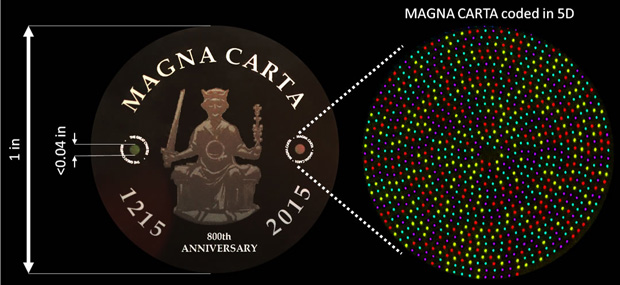
Researchers from the University of Southampton will present the Magna Carta, preserved on a special glass disc that can survive for eternity, to dignitaries at Salisbury Cathedral.
The optical disc, made of nanostructured glass, uses technology that stores vast amounts of data in the volume of nanopatterned glass that is capable of surviving for billions of years.
The presentation will be made at Salisbury Cathedral on Wednesday 15 June.
Professor Peter Kazansky, from the Optoelectronics Research Centre (ORC) at the University of Southampton, explains the reasons behind the presentation: “A one-inch glass disc is inscribed with Latin and English versions of the Magna Carta. It is thrilling to think that we have created the technology to preserve vital documents and store it for unlimited periods for future generations. This technology archives one of the most significant historical documents known to the human race: all we’ve learnt will not be forgotten.”
The gift was made possible thanks to pioneering work from scientists at the ORC, opening up a new era of eternal data archiving. Their research into a ‘5D’ optical storage has for the first time created a way to retain immense quantities of data – up to 360 TB of data on a single CD sized disc; more than 7,000 times more than today’s 50-gigabyte double-layer Blu-ray capacity for 13.8 billion years.
The 5D storage has extremely high data stability as the information is recorded within structural modifications in fused quartz glass, one of the most chemically and thermally durable materials on Earth. The discs can withstand fire and temperatures of up to 1,000 degrees C (1832 degrees F). The glass can withstand direct impact of up to half a ton.
As a very stable and safe form of portable memory, the technology has the potential to transform the way that organisations with big archives, such as national archives, museums and libraries, to preserve their information and records. For organisations that have to back up their archives every five to ten years, because hard-drive memory has a relatively short lifespan, 5D optical storage – dubbed the Superman memory crystal – could be the answer.
The technology was first experimentally demonstrated in 2013 when a 300 kb digital copy of a text file was successfully recorded in 5D.
Now, major documents from human history such as Universal Declaration of Human Rights (UDHR), Newton’s Opticks and King James Bible, have been saved as digital copies that could survive the human race. A copy of the UDHR encoded to 5D data storage was presented to UNESCO by the ORC at the International Year of Light (IYL) closing ceremony in Mexico earlier this year.